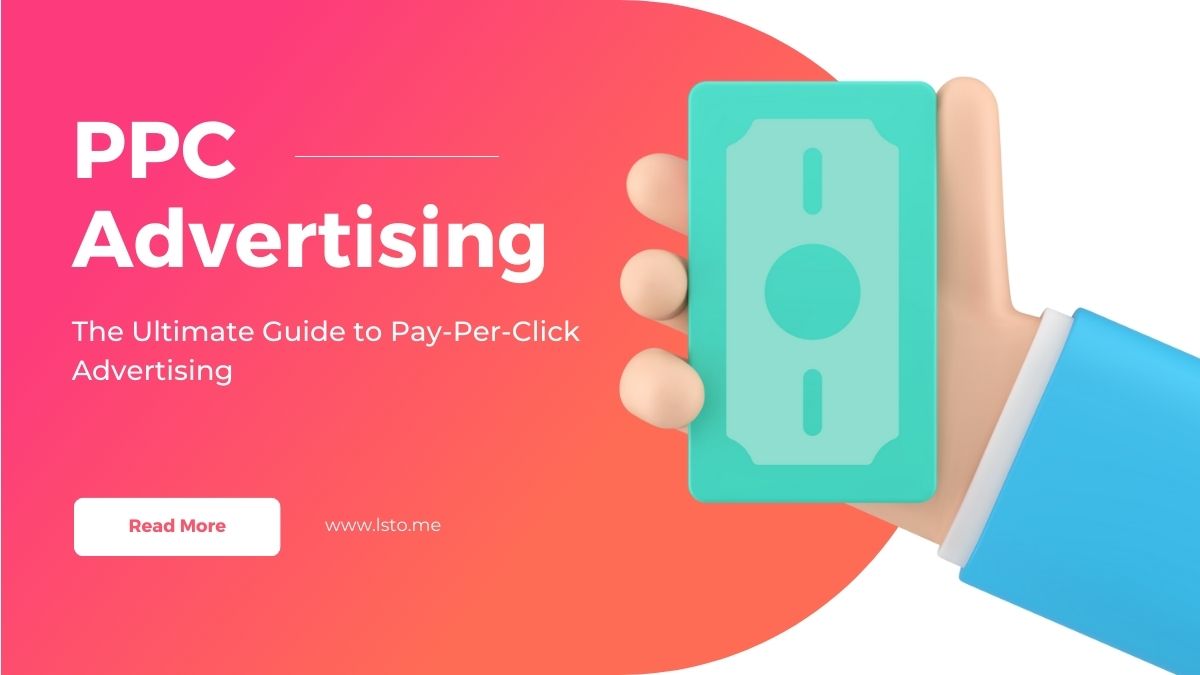
Pay-per-click (PPC) advertising is a highly effective digital marketing strategy that allows businesses to reach their target audience and drive valuable traffic to their websites. Whether you’re new to PPC or looking to refine your existing campaigns, this comprehensive guide will provide you with the knowledge and strategies needed to succeed in PPC advertising.
1. Understanding Pay-Per-Click Advertising:
Pay-Per-Click (PPC) advertising is a form of online marketing where advertisers pay each time someone clicks on their ads. This type of advertising model is commonly used by search engines to display ads alongside search results. The principle behind PPC advertising is simple: advertisers bid for the right to have their ad displayed when users search for specific keywords or phrases.
One key element in understanding how PPC works is the auction system. When you place an ad on a search engine, it will compete with other advertisers who are targeting the same keywords and audience. The winning bidder gets to have their ad displayed in a prominent position, increasing the chances that users will click on it.
Another critical factor in successful PPC advertising is your ad rank, which determines how high up on the page your ad appears compared to other ads competing for similar keywords or phrases.
2. Setting Clear Campaign Goals:
Pay-Per-Click Advertising (PPC) has become an important part of digital marketing over the years. It is a method of advertising where advertisers pay a fee each time their ad is clicked on. PPC advertising can be very effective if done right, but one of the most crucial aspects to consider when running a campaign is setting clear goals. Setting clear campaign goals helps ensure that your PPC efforts are aligned with your business objectives.
The first step in setting clear campaign goals for your PPC advertising is to define what you want to achieve from your campaigns. You need to have a specific goal in mind, whether it’s increasing website traffic, generating leads or sales, or boosting brand awareness. Once you’ve defined your goal, you can then create measurable metrics that will help you track progress toward achieving that goal.
3. Conducting Thorough Keyword Research:
Conducting thorough keyword research is the foundation of any successful PPC campaign. If you want to drive traffic to your website and increase your conversions, you need to identify the right keywords that will attract your target audience. Keyword research allows you to identify the search terms that people use when looking for products or services similar to yours.
To conduct thorough keyword research, it is essential to use keyword research tools like Google Keyword Planner. This tool provides insights into how often a particular keyword is searched for and how competitive it is. It also suggests related keywords that can help expand your reach and improve targeting.
When conducting keyword research, it’s important not just to focus on high-volume keywords but also on long-tail keywords with lower competition. These less competitive search terms may have lower search volume, but they can be more targeted and cost-effective in attracting customers who are closer to making a purchase decision.
4. Creating Compelling Ad Copy:
Pay-Per-Click advertising has become increasingly popular over the years, providing businesses with a cost-effective way to reach their target audience. However, creating compelling ad copy is crucial for attracting clicks and driving conversions. Crafting attention-grabbing headlines and persuasive body copy that speaks directly to the needs of your target market is key.
The first step in creating compelling ad copy is to clearly define your target audience. Know who you are trying to reach, what their pain points are, and how your product or service can solve their problems. Your headline should immediately grab their attention and convey the value of what you have to offer. Use strong language that creates urgency such as “limited time,” “exclusive,” or “don’t miss out” to encourage clicks.
Once you’ve hooked them with your headline, it’s important to keep their interest with persuasive body copy.
5. Designing Landing Pages for Conversion:
Pay-Per-Click (PPC) Advertising is a highly effective way to drive traffic to your website. However, if you don’t have well-designed landing pages, all that traffic will be lost. A landing page is the first point of contact between your business and potential customers. It’s what converts visitors into leads or sales, so you must get it right.
To create high-converting landing pages for PPC campaigns, start by researching your target audience and their needs. This will help you design a page that speaks directly to their pain points and motivates them to take action. Remember to keep the page focused on one specific offer or message, with clear calls-to-action (CTAs) that are easy to find and understand.
In addition to focusing on user experience, pay attention to design elements such as color scheme, font choice, and imagery.
6. Setting Up Conversion Tracking:
Pay-per-click (PPC) advertising is a powerful tool for driving traffic and generating leads to your website. However, the true measure of success for any PPC campaign lies in its ability to convert visitors into paying customers. This is why tracking conversions is essential for measuring the effectiveness of your PPC campaigns.
The first step in setting up conversion tracking is to implement conversion tracking codes on your website. These codes are snippets of JavaScript that you can add to specific pages of your site, such as a thank-you page or checkout confirmation page. When a user completes an action that you want to track, such as making a purchase or filling out a form, the code sends information back to your PPC platform indicating that a conversion has occurred.
Once you have set up conversion tracking codes on your site, you can start monitoring how well your campaigns are performing based on the number of conversions generated.
7. Optimizing Bids and Budget:
Pay-Per-Click (PPC) advertising offers a cost-effective way to drive traffic to your website and increase conversions. But with so many businesses competing for the top spot in search engine results pages, it’s essential to optimize your bids and budget continuously. This will help you maximize your return on investment (ROI) and ensure that you get the most out of your PPC campaigns.
The first step in optimizing your bids and budget is to monitor your campaign performance regularly. By tracking key metrics such as click-through rates, conversion rates, and cost per click, you can identify areas where you need to adjust your strategy. For example, if a particular keyword is driving a lot of clicks but few conversions, you may need to revise your ad copy or landing page to make it more relevant to potential customers.
8. A/B Testing and Experimentation:
Pay-per-click (PPC) advertising has become a popular marketing strategy for businesses to drive traffic and conversions. However, achieving success in PPC campaigns requires continuous experimentation and testing. One of the most effective methods to improve your PPC campaigns is A/B testing.
A/B testing involves comparing two different variations of an ad or landing page to determine which one performs better. It enables advertisers to identify the elements that resonate with their target audience and optimize their campaigns accordingly. Advertisers can test different ad formats, headlines, images, calls-to-action (CTAs), landing page designs, or targeting options to see what works best for their business.
By conducting A/B testing regularly, advertisers can make data-driven decisions and refine their PPC campaigns over time. This approach helps them save money by eliminating ineffective ads or targeting options while improving the ROI of their marketing efforts.
9. Monitoring and Performance Analysis:
Pay-per-click (PPC) advertising is a popular marketing strategy that helps businesses generate leads and drive sales. However, to get the most out of your PPC campaigns, it is important to regularly monitor their performance and analyze key metrics such as click-through rates (CTR), conversion rates, ad spend, and return on investment (ROI).
By monitoring your PPC campaign performance, you can identify which ads are working well and which ones need improvement. This allows you to make data-driven decisions about where to allocate your budget for maximum impact. For example, if an ad isn’t getting many clicks or conversions despite a high spend, it may be time to revise the ad copy or targeting settings.
Analyzing key metrics such as CTR can also help you optimize your PPC campaigns for better results. A higher CTR means more people are clicking on your ads, indicating they are relevant and engaging.
10. Staying Updated and Evolving:
Pay-Per-Click (PPC) advertising is a rapidly evolving landscape, and staying updated with industry trends and platform updates is crucial for success. PPC campaigns have become an essential part of the digital marketing mix, allowing businesses to reach their target audiences quickly and effectively. However, as the competition for online visibility intensifies, keeping up with new advertising trends can be challenging.
One of the main challenges in PPC advertising is ensuring that your strategy remains relevant amid changing algorithms and market conditions. By staying informed about the latest news in PPC marketing trends, you can refine your approach and stay ahead of the curve. This could mean adapting your targeting strategies to include voice search or creating mobile-specific ads that cater to on-the-go consumers.
Another aspect of staying updated with PPC advertising involves regularly checking platform updates on popular platforms like Google Ads or Facebook Ads Manager.
Conclusion:
Mastering pay-per-click advertising requires a deep understanding of its principles, strategic planning, and ongoing optimization. By following this ultimate guide, you’ll be equipped with the knowledge and strategies needed to create effective PPC campaigns, attract quality traffic, and achieve your advertising goals. Remember to track performance, make data-driven decisions, and stay updated to continuously improve and maximize the results of your PPC advertising efforts.




